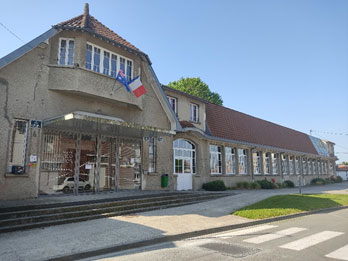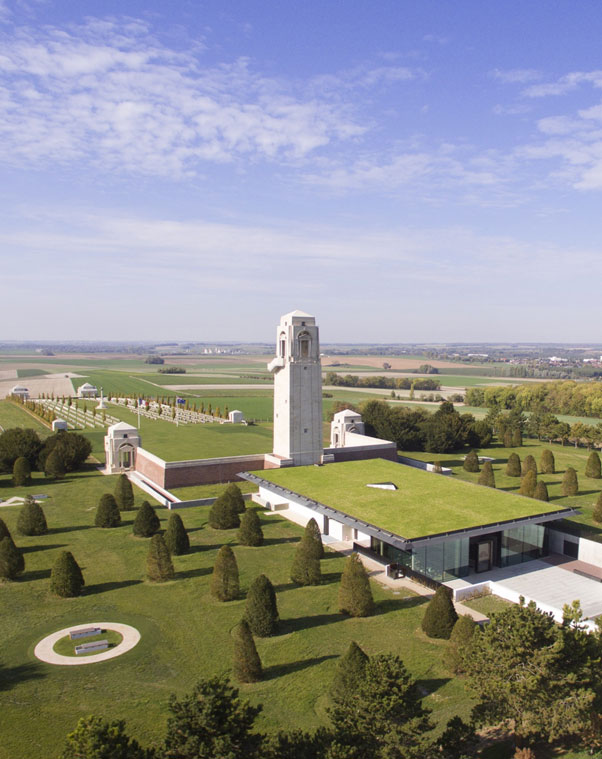The Australian Remembrance Trail along the Western Front and the Sir John Monash Centre
Australia's commitment on the Western Front between 1916 and 1918 was one of the most important events in our nation's history. For the first time, Australians played a major role in world events, and made a substantial contribution to the outcome of the war. The Western Front had a fundamental effect on Australia's approach to war, as well as on Australian politics, families, and national attitudes
Back to top
Historical background
The Western Front directly touched the lives of countless Australian families. Of the 295,000 Australians who served on the Western front, more than 46,000 died and more than 130,000 Australians were wounded. The Western Front fatalities amount to 75% of the approximately 60,000 Australians who died in the First World War.
The Australian Remembrance Trail (ART) along the Western Front, funded in the 2009-10 Budget, serves to help Australians and other visitors to the Western Front learn about the Australian experience of war in France and Belgium in the First World War.
It builds upon the existing efforts of French and Belgian communities to commemorate Australian service, some of which date back to the 1920s.
Today, the 200-kilometre ART along the Western Front highlights the Australian experience of war in France and Belgium between mid-1916 and late 1918. The ART runs from Ypres, Belgium, near the site of the Battle of Passchendaele, through Fromelles, Bullecourt and Pozières to Villers-Bretonneux in northern France. Along the Trail are battlefields, cemeteries, memorials, museums, and the imprints that Australian soldiers left on this landscape.
Supported by a comprehensive and easily accessible set of materials, the ART informs and guide visitors of all ages, levels of fitness, and amounts of travel time. Visitors can view key locations at which Australians fought, and visit high quality interpretive centres that present Australian material, while also visiting related sites of Australian interest.
The interpretive materials assume no prior knowledge of military history and are available in a mix of traditional and digital media formats. The ART and associated materials provide ample opportunity for contemplative reflection.
To learn more about the Australian Remembrance Trail please visit the Australians on the Western Front 1916-1918.
Download a digital copy of the Australian Remembrance Trail along the Western Front Brochure.

A map of the Australian Remembrance Trail along the Western Front.
Back to topIn France
At Dernancourt, a walking trail tells the story of Australia’s involvement here in 1918 in stopping a major German offensive. Sites of significance encompassed by the trail include: the Pavilion Adelaide, the school hall named in tribute to the support Dernancourt received from the city of Adelaide and the state of South Australia after the War; the railway embankment, where men of the 4th Division held the German advance; the Support Line trench between the railway and the Amiens road; a position known as ‘the Quarry’; and at the old Communal Cemetery, a scene of heavy fighting.
At Pozières, where Australia sustained 23,000 casualties in little over six weeks in 1916, visitor facilities provide interpretation, parking, traffic access, and picnic facilities. A number of walks encompass points of significance including the 1st Australian Division Memorial, the Gibraltar blockhouse that was captured by Australians, and the Windmill site, ‘a ridge more densely sown with Australian sacrifice than any other place on earth’ (C.E.W. Bean).
At Villers-Bretonneux a major refurbishment of the Franco-Australian Museum, which commemorates the decisive battle fought there by Australians on the night of 24-25 April 1918, was completed in 2017. Located within the Victoria School, which was built with money raised in Australia after the War, the museum also honours the remarkable relationship between the town and Australia that continues to this day. Visit the Franco-Australian Museum website for more information.

Franco-Australian Museum, at Villers-Bretonneux in France.
Close by are the Australian National Memorial, site of the Australian Government led Anzac Day Dawn Service, and the Adelaide Cemetery, from where the Unknown Soldier was disinterred before his reinternment in the Hall of Memory at the Australian War Memorial in Canberra in 1993.
The Sir John Monash Centre is located behind the Australian National Memorial near Villers-Bretonneux. See further below for more information.
The Battle of Fromelles Museum, adjacent to the Fromelles (Pheasant Wood) Military Cemetery tells the story of Australia’s first battle in France, the disastrous 1916 Battle of Fromelles, and includes objects on loan from the Australian War Memorial and other collections. It also tells the story of the discovery and recovery of the remains of 250 Australian and British soldiers who died at Pheasant Wood near Fromelles in 1916. The men, who had previously been recorded as missing, were reinterred in the Fromelles (Pheasant Wood) Military Cemetery in 2010. Nearby, are the Cobbers memorial, and V.C. Corner Australian Cemetery and Memorial. Visit the museum’s website for more information.

The Battle of Fromelles Museum, at Fromelles in France.
At Péronne, working in partnership with the Historial de la Grande Guerre, the Australian Remembrance Trail assists visitors to interpret the battles for Mont St Quentin and Péronne. These battles are considered by many to be among the greatest achievements of the Australian Army in the First World War. The works include an interpretive room in the Historial and walking trails at Mont St Quentin and Péronne. Visit the Historial de la Grande Guerre website.
The Jean and Denise Letaille Museum at Bullecourt, opened on Anzac Day 2012 and, through a wealth of objects collected by Jean Letaille OAM, tells the story of the two bloody battles fought by Australians at Bullecourt in April and May 1917. Nearby is the Digger memorial, site of an Australian Government led Anzac Day service. For more information about the museum visit this website.
The Australian Remembrance Trail incorporates the Australian Corps Memorial at Le Hamel which commemorates and interprets the 4 July 1918 Battle of Le Hamel. The battle was fought by the Australian Corps which was commanded for the first time by General John Monash. This ‘model victory’ would become the template for future Allied operations on the Western Front. The Memorial at Le Hamel was formally rededicated in 2008 by Governor-General Bryce following significant restorations.
In Vignacourt the Thuillier’s farmhouse has been converted into the Vignacourt 14-18 Interpretive Centre, which opened in 2018. In the very place where Australian soldiers posed for portraits, visitors can learn more about life for the Australian troops behind the lines and view part of the Thuillier collection. Nearby, 424 Australians are buried in Vignacourt British Cemetery. To learn more about the Vignacourt 14-18 Interpretive Centre, visit their website.
The Underground City of Naours is a network of tunnels dating back to the Middle Ages. During the First World War Australian soldiers visited the tourist attraction while on leave. Many inscribed their names on the limestone walls, which can still be seen today. In 2020, the site opened the Silent Soldiers of Naours Interpretive Centre to share these men’s stories. Visit the Silent Soldiers of Naours website to learn more about the tunnels and graffiti.
The Commonwealth War Graves Commission (CWGC) Visitor Centre at Beaurains, near Arras is a unique interpretive centre that highlights the remarkable work of the CWGC. The visitor centre gives an up close and intimate look behind the scenes at the teams who work painstakingly to care for the fallen. Visitors will learn the story of how the dead are still recovered and reburied today, and how skilled artisan craftsmen maintain the world’s most impressive and recognisable monuments and memorials. Learn more about the CWGC and visitor centre here.
Back to topIn Belgium
The Plugstreet 14-18 Experience interpretive centre at Ploegsteert, focussing on the Australian contribution to the Battle of Messines, opened in 2013. Located adjacent to the Ploegsteert Memorial, the interpretive centre is close to Toronto Avenue Cemetery, the only all Australian cemetery in Belgium. Visit the Plugstreet 14-18 Experience website.

The Plugstreet 1914-1918 Experience, at Ploegsteert in Belgium.
Following an invitation from the community of Zonnebeke, to further interpret Australia’s involvement in the Battle of Passchendaele, the Australian Government has established an Australian section in the Passchendaele Memorial Garden, in the grounds of the Memorial Museum Passchendaele. Nearby is Tyne Cot Cemetery, the largest Commonwealth War Graves Cemetery in the world, which incorporates several wartime German blockhouses captured by Australians. Visit the Memorial Museum Passchendaele 1917 website.
The In Flanders Fields Museum at Ieper (Ypres) incorporates Australian content into its displays themed on the great battles fought near Ieper (Ypres) between 1914 and 1918. A short walk away is the Menin Gate Memorial, site of the moving Last Post Ceremony each evening and a remarkable point at which to start or finish a visit to the Western Front. Visit the In Flanders Fields Museum website.
Back to topThe Sir John Monash Centre
Located at the heart of the Australian Remembrance Trail, the Sir John Monash Centre is an international standard interpretive centre sharing Australia’s story on the Western Front in the words of those who served.
Set on the grounds of the Villers-Bretonneux Military Cemetery in northern France, and adjacent to the Australian National Memorial, the Sir John Monash Centre (SJMC) was officially opened on 24 April 2018. The Centre’s experience is designed for visitors to gain a better understanding of the journey of ordinary Australians — told in their own words through letters, diaries, and life-size images — and connect with the places they fought and died.
This cutting-edge multimedia centre reveals the Australian First World War experience through a series of interactive media installations and immersive experiences available in English, French and German. The SJMC app, downloaded on each visitor’s personal mobile device, acts as a ‘virtual tour guide’ over the Villers-Bretonneux Military Cemetery, the Australian National Memorial and the Sir John Monash Centre.
A visit to the SJMC will be a moving experience that leaves a lasting impression and an enhanced understanding of Australia’s role, impact and loss suffered on the Western Front. To learn more visit the Sir John Monash Centre’s website.

Aerial view of the Sir John Monash Centre on the grounds of the Villers-Bretonneux Military Cemetery in northern France
Back to top